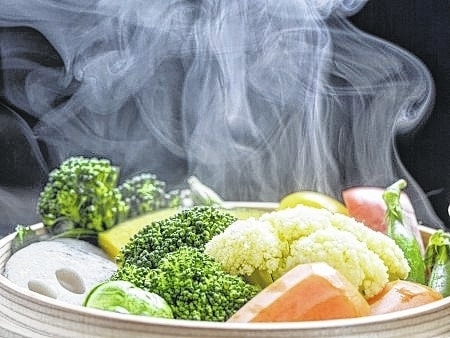
Question: What is the best way to cook vegetables so nutrients aren’t destroyed?
Answer: You’re right. The heat involved in cooking vegetables can destroy some nutrients, but for others, it actually enhances their absorbability. For example, both beta carotene (think carrots) and its relative, lycopene (tomatoes), are more easily absorbed by the body after cooking. Cooking changes the structure of these nutrients’ molecules, allowing our bodies to absorb them much more efficiently. Adding some healthy fat, such as olive or canola oil, also helps.
With different nutrients reacting differently to the cooking process, it can get confusing. As a general rule, limit cooking time: The less time a vegetable is exposed to heat, the more nutrients it will retain.
You’ll also want to limit the amount of water that vegetables are exposed to in both food preparation and cooking, because water-soluble vitamins, such as folate and vitamin C, easily leach out when vegetables are soaked or cooked in lots of water. So boiling vegetables in a pot full of water should almost always be your last choice if you want to maximize retention of nutrients.
Steaming is a great option, either in the microwave oven or on the stovetop. The cooking process is fast, which limits the vegetables’ exposure to heat, and it prevents vegetables from sitting in water.
In the microwave, the steam and the energy itself work together to heat vegetables rapidly. Because microwave ovens widely differ in wattage, it might take some trial and error so vegetables cook evenly and don’t get overdone. Believe it or not, it can be helpful to read the appliance manual and follow its recommendations. If you can’t find your copy, look online. Whether in the microwave oven or on the stovetop, be sure to use a tightly lidded container so the steam doesn’t escape and the vegetables cook more quickly.
Dry methods of cooking, such as roasting or grilling, are other great options. Be sure to coat vegetables with a thin layer of oil to help their surfaces heat more quickly, allowing them to cook faster. Dry cooking methods also remove moisture, helping create a richer, more intense flavor than other cooking methods.
Whatever cooking method you choose, keep these other nutrient-retaining hints in mind:
If a vegetable has an edible skin — potatoes or summer squash, for example — leave it on. Many nutrients are concentrated in or just below the skin, and the skin protects the vegetables from losing nutrients during the cooking process.
When cutting vegetables before cooking, opt for larger chunks. The less surface area that’s exposed to heat, the fewer nutrients you’ll lose.
Don’t crowd. Cook vegetables in a loose pile or a single layer to allow the heat to access all food surfaces quickly and evenly. Again, the quicker vegetables cook, the more nutrients you get.
Cooking vegetables properly just might encourage you to eat more of them. Berkeley Wellness, part of the University of California, Berkeley School of Public Health, has a helpful guide, “60+ Healthy Ways to Cook Vegetables” at berkeleywellness.com — search for “cooking vegetables.”


